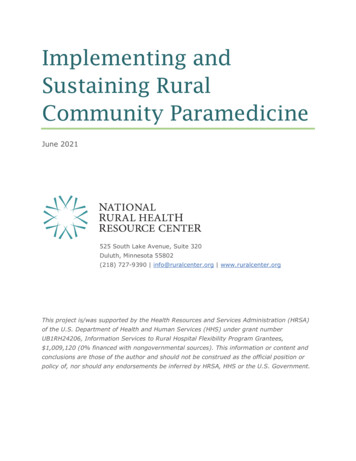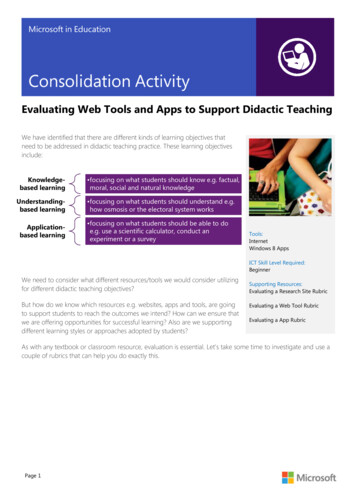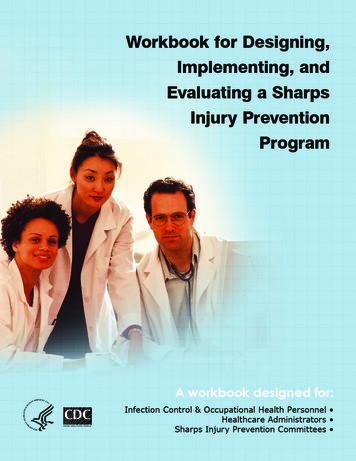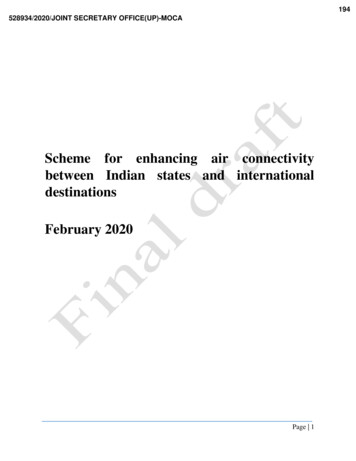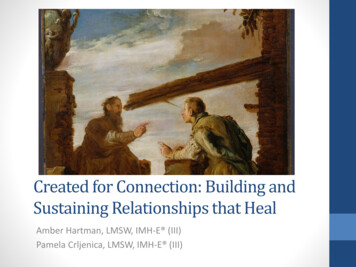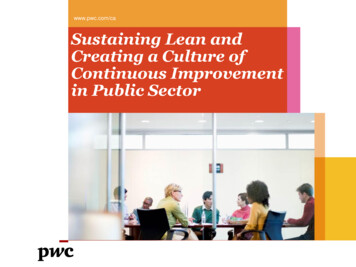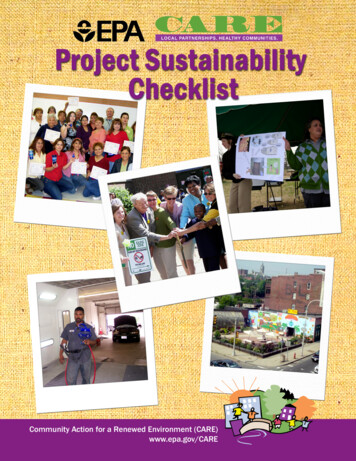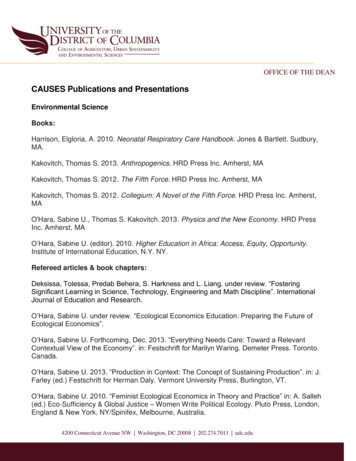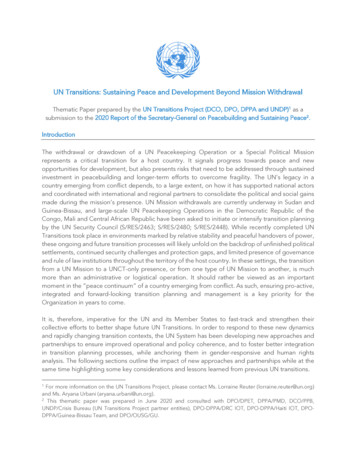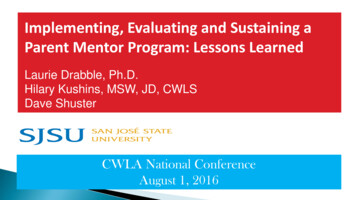
Transcription
Implementing, Evaluating and Sustaining aParent Mentor Program: Lessons LearnedLaurie Drabble, Ph.D.Hilary Kushins, MSW, JD, CWLSDave ShusterCWLA National ConferenceAugust 1, 2016
AcknowledgementsThe Mentor Parent Program is supported by Santa ClaraCounty Board of Supervisors and Behavioral HealthThe Child Welfare Partnership for Research and Training(CW-PART) is supported by the California Social WorkEducation Center & Title IV-E Training Program
MENTOR PARENTPROGRAMDependency Advocacy CenterSanta Clara County, California
Functions of Recovery SupportLIASON Links participants to ancillary supports;identifies service gapsTREATMENT BROKER Facilitates access to treatment by addressingbarriers and identify local resources Monitors participant progress andcompliance Enters case dataADVISOR Educates community; garners local support Communicates with FDC team, staff andservice providers4
DEPENDENCY WELLNESS COURT (DWC) Started in1998 Judge, attorneys, Social Services,Dept. of Alcohol and DrugServices, attorneys. Voluntary program.1998 Limited resources and fewparticipants. Off the record, informal. Samejudge for legal and drug courthearings (unless contested).
DEPENDENCY WELLNESS COURT (DWC) 2007 In 2007, received 5 year federal grant toexpand drug court, Family Wellness CourtFirst Five matching funds.Expanded partners from original drug court,including DAC and Mentor Parents, First Five,domestic violence/trauma specialist, CASA,and mental health.The Oversight Committee met monthly,consisting of heads of all representedagencies on drug court team to addressissues as they arose in drug court on a policylevel.Grant ended in 2012. Partners committed tocontinuing model, with strong judicialleadership
DEPENDENCY WELLNESS COURT (DWC)Today Merged drug court from 1998 andfederal grant drug court to one drugcourt, DWC, in 2012 when federalgrant ended. Voluntary program. Separate drug court and legal hearingswith different judicial officers (parallelmodel). 100-120 active parents at any giventime. 2 full days per week. Challenges of evaluating DWC. Oversight Committee continues tomeet on a regular basis.
Peer mentoring program. Employees of parents'attorney firm (DependencyAdvocacy Center). Communications withclients covered underattorney client privilege 5 mothers, 3 fathers Director and clinicalsupervisor Average caseload 25 clients Work 30 hours per weekMENTOR PARENTS
Committed to clean and soberlifestyle and raising healthyfamilies. Successful graduate ofdependency drug court. Successfully reunified with theirchildren and had theirdependency case dismissed. No pending criminal cases orcharges. Willing to share their story.CRITERIA TO BE A MENTOR
Recruit eligible parents into DWC Establish professional boundaries Provide only referrals or facilitateservice delivery of court orderedprograms and those directlyrelated to recovery Provide support at drug court andlegal hearings and throughoutdependency court process Maintain confidentialcommunications (protected underattorney client privilege)ROLES AND RESPONSIBILITIES Participate in various trainings, includingDFCS, CASA.
ROLE THEY PLAY IN THE SYSTEM Integral part of committeeswhere policy gets decided(Oversight) Educate new DWC teammembers Participate in trainings forDFCS (court report writing,engaging fathers), CASA (birthparent perspective,understanding addiction)
FUNDING Began as one volunteer for 5 hours a week,first drug court graduate. Dept. of Alcohol and Drug Services (DADS)first funder and focused on mothers. Mentors included in 2007 federal grant: 4mentors (inc. 2 fathers) and one manager Dept. of Mental Health (DMH) then funded 2more mentors in 2009 Federal Evaluation - mentor program one ofthe most effective pieces of the drug courtprogram Federal grant expired, Santa Clara Board ofSupervisors (BOS) continued funding forMentor Parent Program Current funding: 70% Board of Supervisors,30% Behavioral. Health Services Dept. for atotal of 425,000/year.
SJSU Washington SquareThe CW-PART is a collaborative project between School ofSocial Work at SJSU and local agencies working with childrenand families Teams of students work under supervision of faculty to focuson research questions defined as priorities to local agencies. Development was funded through California Social WorkEducation Center
SJSU Washington SquareHOW IT WORKSFaculty leads work with agency todefine research projects Students complete research overacademic year Findings are provided to countythrough research summaries Integrated into Title IV-E ChildWelfare Training Program at SJSU
SJSU Washington SquareWHY THE PARTNERED MODEL? It provides learningopportunities for students Helps address questions ofinterest to the county/ localagencies Supports capacity building
SJSU Washington SquareBENEFITS & CHALLENGES: AGENCY/COUNTYBENEFITS Research projects are beneficial tocounty/agency planning andevaluation. Leverages resources in support ofcounty initiatives and projects (e.g.,faculty consultation). Minimizes potential burdens ofaccompany individual projects.CHALLENGES Time investment(planning,providing data) Timing to fitacademic year
SJSU Washington SquareBENEFITSCHALLENGES Time investment (partners, Effective strategy forstudents, logistics like IRB)teaching Timing work to match Meaningful projectsstudent and county Stronger relationships withconstraintspartner agencies/ practice Competing demands (e.g.,publishable research)
SJSU Washington SquareBENEFITSCHALLENGES Makes research more meaningfulresearch that contributes to the field. Greater possibility of sharingresearch findings. Opportunity for collaboration anddeveloping relationships. More support and guidance fromresearch lead faculty. Opportunity to learn from otherstudent perspectives and theirresearch findings. Conflicting schedules amongservice providers andstudents. Challenging to schedulemultiple focus groups andinterviews. Students may be at their fieldplacement, class or job. Requires research teammembers to be very flexible.
SJSU Washington SquareCAPACITY BUILDING - CONSULTATION Assistance in development of logic model Problem-solving related to evaluationinfrastructure and protocols Development and piloting of evaluationinstruments for DAC/MPP- Client satisfaction survey- Self-sufficiency assessment- Development of DWC evaluation tools
SJSU Washington SquareTHEORY: EXCERPTS FROM MPP “LOGIC MODEL”SHORT-TERM OUTCOMES Engagement andretention in DWC Engagement in MPPsupport services Access to treatment andother servicesINTERIM OUTCOMES Increased self-sufficiency inrecovery, legal status, socialsupport, and other lifedomains Engagement in selfhelp/recovery Abstention/ reduction insubstance abuseLONG-TERM OUTCOMES Successful reunificationat MPP programcompletion Reduction in recurrenceof maltreatment/reduced days in fostercare Long-term sobriety
SJSU Washington SquareILLUSTRATION: MEASURINGSELF-SUFFICIENCY PROJECT Identification of domains throughfocus groups with Mentor Parents Pilot adapted version of SelfSufficiency Matrix Report back and feedback onchallenges, and/or discoveries inadministering the Self-SufficiencyMatrix
Baseline ScoresPost scores(12 months)Self-Sufficiency DomainsMean (SD)Mean (SD)p-valueHousing1.55 (0.85)3.47 (1.39) .001Employment1.09 (0.39)2.16 (1.29) .001Mobility (transportation)1.34 (0.60)2.69 (1.42) .001Life Skills2.39 (1.09)4.00 (1.02) .001Family/Social Relations2.22 (1.04)3.66 (1.07) .001Community Involvement1.87 (0.88)3.71 (0.96) .001Parenting Skills1.93 (1.08)3.78 (0.94) .001Legal2.84 (1.49)3.77 (1.28) .004Substance Abuse2.38 (1.43)4.56 (0.88) .001
SJSU Washington SquareRESEARCH/EVALUATION PROJECTS Evaluation of unique contribution of mentor parent program Qualitative interviews/surveys with stakeholders Client satisfaction and client engagement surveys Client focus groups Evaluation of outcomes Re-unification and re-entry Increase self-sufficiency Website: https://sites.google.com/a/sjsu.edu/cw-part/
SJSU Washington SquareHIGHLIGHTS OF PARTNERSHIP OUTCOMES Documentation of MPP impact on DWC engagement andincreased self-sufficiency Documentation of relationship between MPPparticipation/contact hours and reunification Evaluation findings used in report to funders Parallel consultation to address data collection instrumentsand infrastructure with DWC; influencing practice in othertherapeutic courts
SJSU Washington SquareRESEARCH/EVALUATION PROJECTS Evaluation of unique contribution of mentor parent program Qualitative interviews/surveys with stakeholders Client satisfaction and client engagement surveys Client focus groups Evaluation of outcomes Re-unification and re-entry Increase self-sufficiency Website: https://sites.google.com/a/sjsu.edu/cw-part/
Create visibility with your mentors. What committees can they sit on? Whoshould they meet with? Where does policy get decided?Who can the mentors train? Social workers? Judges? Team members?Increases visibility of the program and establishes support fromstakeholders.Evaluate your program. What do you want to measure? How will youmeasure it? What data do you need to collect? Who can help you obtainthat data?Create mutually beneficial partnerships to sustain program. Whichuniversity/college/community college is near you? Is there a school ofsocial work near you?Have both hard data to support your program and a mentor to publiclyshare their story: a winning combination for potential funders.
SJSU Washington SquareLESSONS LEARNED FOR RESEARCH PARTNERSHIP1. Liaisons in each system for managing the overall partnership,brokering resources, and serving as conduits between systems2. Support of leadership in both the agency and university3. A structured process for identification of research questions4. Multi-year projects centered on key county initiatives aremore feasible and meaningful than multiple smaller projects.5. Organizational assets are critical, including facultyexpertise, relevant courses in curriculum, adequate numbersof interns/students, funding for planning
SJSU Washington SquareLESSONS LEARNED FOR RESEARCH PARTNERSHIP6. Importance of orientation for students, field instructors,and other partners7. Course assignments may require adaptation8. Coordination is important to maximize the “team”experience9. Flexibility and maintaining communication, through keyidentified liaisons are critical to problem solving abouttiming issues, data, and other challenges that may arise10. Attending to the partnership and efforts to build socialcapital are as important as the research products.
Hilary Kushins, MSW, JD, CWLSDependency Advocacy CenterDrug Court &Training Programs Manager111 W. Saint John Street,Suite 333CSan Jose, CA 95113phone: (408) 999-0311hkushins@sccdac.orgLaurie Drabble, Ph.D.ProfessorSan Jose State UniversitySchool of Social WorkOne Washington SquareSan Jose, CA 95192-0124phone: (408) 924-5836lauriedrabble@sjsu.eduDave ShusterDependency Advocacy Center111 W. Saint John Street, Suite 333San Jose, CA 95113phone: (408) 516-7470dshuster@sccdac.org
Hilary Kushins, MSW, JD, CWLS. Dependency Advocacy Center Drug Court & Training Programs Manager 111 W. Saint John Street, Suite 333C San Jose, CA 95113 phone: (408) 999 -0311 hkushins@sccdac.org . Laurie Drabble, Ph.D. Professor San Jose State University School of Social Work One Washington Square San Jose, CA 95192-0124 phone: (408) 924 -5836
